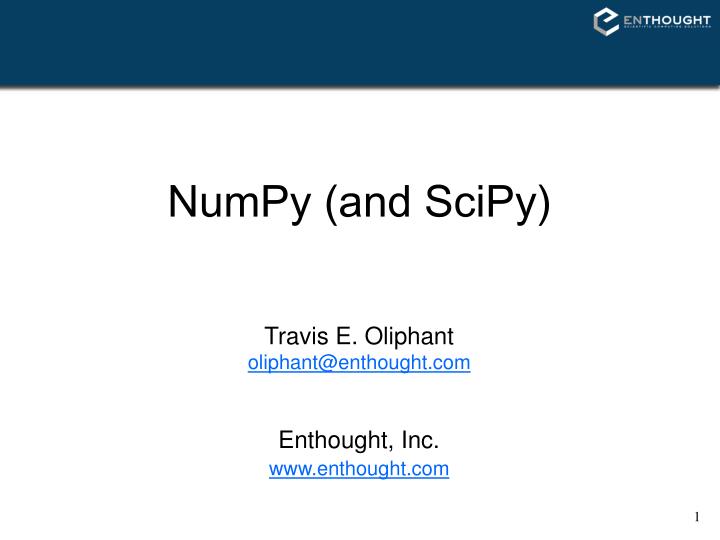

It explains each module for scientific computing with examples. This article highlights the difference between the NumPy and SciPy. This is the starting documentation from SciPy itself so should cover the basic ground. This starts with advantages of SciPy over various available tools. This is an introductory tutorial about SciPy. The different chapters each correspond to a 1 to 2 hours course with increasing level of expertise, from beginner to expert. It has a quick introduction to central tools and techniques. This is a complete tutorial about scientific Python computing. This tutorial brings you a complete exploration of NumPy libraries and makes you think in the Numpy way.

This video tutorial by edureka is an introduction to NumPy and is described in detail.
#Numpy scipy install#
In most use cases the best way to install NumPy on your system is by using a pre-built package for your operating system. It provides an overview of Numpy, the core tool for performant numerical computing with Python. These are general instructions for installing packages in the SciPy ecosystem. These tutorials are authored by Emmanuelle Gouillart, Didrik Pinte, Gaël Varoquaux, and Pauli Virtanen. This is an ideal choice for people who are looking for videos instead of books. This is Introductory video tutorial of NumPy by. The tutorial by quantwiki gives a brief introduction and explores the NumPy libraries with real time examples. This is an ideal choice for people who already have an idea about NumPy and looking to explore it more. It was taught along with Python in advanced learning topics. Introduction into NumPy is an another tutorial hosted by. Sam’s tutorial on scientific python tools is well documented & with an organised explanation. Tensor learning, algebra and backends to seamlessly use NumPy, MXNet, PyTorch, TensorFlow or CuPy.Here is a list of 13 Numpy and SciPy tutorials. Python backend system that decouples API from implementation unumpy provides a NumPy API. Multi-dimensional arrays with broadcasting and lazy computing for numerical analysis.ĭevelop libraries for array computing, recreating NumPy's foundational concepts.

NumPy-compatible sparse array library that integrates with Dask and SciPy's sparse linear algebra.ĭeep learning framework that accelerates the path from research prototyping to production deployment.Īn end-to-end platform for machine learning to easily build and deploy ML powered applications.ĭeep learning framework suited for flexible research prototyping and production.Ī cross-language development platform for columnar in-memory data and analytics. Labeled, indexed multi-dimensional arrays for advanced analytics and visualization NumPy-compatible array library for GPU-accelerated computing with Python.Ĭomposable transformations of NumPy programs: differentiate, vectorize, just-in-time compilation to GPU/TPU. NumPy's API is the starting point when libraries are written to exploit innovative hardware, create specialized array types, or add capabilities beyond what NumPy provides.ĭistributed arrays and advanced parallelism for analytics, enabling performance at scale. With this power comes simplicity: a solution in NumPy is often clear and elegant.
#Numpy scipy for free#
NumPy brings the computational power of languages like C and Fortran to Python, a language much easier to learn and use. But NumPy alone is a CPU-only library - and a single-threaded one at that - and in a world where it's possible to get a GPU or a CPU with a large core count in the cloud cheaply or even for free in a matter of seconds, that may not seem enough. Nearly every scientist working in Python draws on the power of NumPy.


 0 kommentar(er)
0 kommentar(er)
